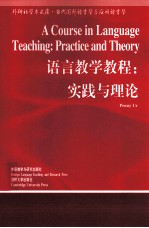

语言教学教程:实践与理论PDF电子书下载
- 电子书积分:13 积分如何计算积分?
- 作 者:(英)厄尔(Ur P.)著
- 出 版 社:北京:外语教学与研究出版社;剑桥大学出版社
- 出版年份:2012
- ISBN:7560085296
- 页数:380 页
Introduction 1
PartⅠ The teaching processModule 1: Presentations and explanationsUnit One: Effective presentation 11
Unit Two: Examples of presentation procedures 13
Unit Three: Explanations and instructions 16
Module 2: Practice activitiesUnit One: The function of practice 19
Unit Two: Characteristics of a good practice activity 21
Unit Three: Practice techniques 24
Unit Four: Sequence and progression in practice 27
Module 3: TestsUnit One: What are tests for? 33
Unit Two: Basic concepts; the test experience 35
Unit Three: Types of test elicitation techniques 37
Unit Four: Designing a test 41
Unit Five: Test administration 42
PartⅡ Teaching the language(1):The'what' 46
Module 4: Teaching PronunciationUnit One: What does teaching pronunciation involve? 47
Unit Two: Listening to accents 50
Unit Three: Improving learners' pronunciation 52
Unit Four: Further topics for discussion 54
Unit Five: Pronunciation and spelling 56
Module 5: Teaching vocabularyUnit One: What is vocabulary and what needs to be taught? 60
Unit Two: Presenting new vocabulary 63
Unit Three: Remembering vocabulary 64
Unit Four: Ideas for vocabulary work in the classroom 68
Unit Five: Testing vocabulary 69
Module 6: Teaching grammarUnit One: What is grammar? 75
Unit Two: The place of grammar teaching 76
Unit Three: Grammatical terms 78
Unit Four: Presenting and explaining grammar 81
Unit Five: Grammar practice activities 83
Unit Six: Grammatical mistakes 85
Module 7: Topics, situations, notions, functionsUnit One: Topics and situations 90
Unit Two: What ARE notions and functions? 92
Unit Three: Teaching chunks of language: from text to task 93
Unit Four: Teaching chunks of language: from task to text 96
Unit Five: Combining different kinds of language segments 98
PartⅢ Teaching the Ianguage (2): The ‘how’ 103
Module 8: Teaching listeningUnit One: What does real-life listening involve? 105
Unit Two: Real-life listening in the classroom 107
Unit Three: Learner problems 111
Unit Four: Types of activities 112
Unit Five: Adapting activities 115
Module 9: Teaching speakingUnit One: Successful oral fluency practice 120
Unit Two: The functions of topic and task 122
Unit Three: Discussion activities 124
Unit Four: Other kinds of spoken interaction 129
Unit Five: Role play and related techniques 131
Unit Six: Oral testing 133
Module 10: Teaching readingUnit One: How do we read? 138
Unit Two: Beginning reading 141
Unit Three: Types of reading activities 143
Unit Four: Improving reading skills 147
Unit Five: Advanced reading 150
Module 11: Teaching writingUnit One: Written versus spoken text 159
Unit Two: Teaching procedures 162
Unit Three: Tasks that stimulate writing 164
Unit Four: The process of composition 167
Unit Five: Giving feedback on writing 170
PartⅣ Course content 175
Module 12: The syllabusUnit One: What is a syllabus? 176
Unit Two: Different types of language syllabus 177
Unit Three: Using the syllabus 179
Module 13: MaterialsUnit One: How necessary is a coursebook? 183
Unit Two: Coursebook assessment 184
Unit Three: Using a coursebook 187
Unit Four: Supplementary materials 189
Unit Five: Teacher-made worksheets and workcards 192
Module 14: Topic contentUnit One: Different kinds of content 197
Unit Two: Underlying messages 199
Unit Three: Literature (1): should it be included in the course? 200
Unit Four: Literature (2): teaching ideas 202
Unit Five: Literature (3): teaching a specific text 206
PartⅣ Lessons 212
Module 15: Lesson planningUnit One: What does a lesson involve? 213
Unit Two: Lesson preparation 215
Unit Three: Varying lesson components 216
Unit Four: Evaluating lesson effectiveness 219
Unit Five: Practical lesson managemeut 222
Module 16: Classroom interactionUnit One: Patterns of classroom interaction 227
Unit Two: Questioning 229
Unit Three: Group work 232
Unit Four: Individualization 233
Unit Five: The selection of appropriate activation techniques 237
Module 17: Giving feedbackUnit One: Different approaches to the nature and function of feedback 242
Unit Two: Assessment 244
Unit Three: Correcting mistakes in oral work 246
Unit Four: Written feedback 250
Unit Five: Clarifying personal attitudes 253
Module 18: Classroom disciplineUnit One: What is discipline? 259
Unit Two: What does a disciplined classroom look like? 260
Unit Three: What teacher action is conducive to a disciplined classroom? 262
Unit Four: Dealing with discipline problems 264
Unit Five: Discipline problems: episodes 267
PartⅥ Learner differences 273
Module 19: Learner motivation and interestUnit One: Motivation: some background thinking 274
Unit Two: The teacher's responsibility 276
Unit Three: Extrinsic motivation 277
Unit Four: Intrinsic motivation and interest 280
Unit Five: Fluctuations in learner interest 282
Module 20: Younger and older learnersUnit One: What difference does age make to language learning? 286
Unit Two: Teaching children 288
Unit Three: Teaching adolescents: student preferences 290
Unit Four: Teaching adults: a different relationship 294
Module 21: Large heterogeneous classesUnit One: Defining terms 302
Unit Two: Problems and advantages 303
Unit Three: Teaching strategies (1): compulsory + optional 307
Unit Four: Teaching strategies (2): open-ending 309
Unit Five: Designing your own activities 312
■ And beyond 312
Module 22: And beyondUnit One: Teacher development: practice, reflection, sharing 318
Unit Two: Teacher appraisal 322
Unit Three: Advancing further (1): intake 324
Unit Four: Advancing further (2): output 327
Bibliography 360
Index 367
- 《SQL与关系数据库理论》(美)戴特(C.J.Date) 2019
- 《高级英语阅读与听说教程》刘秀梅编著 2019
- 《联吡啶基钌光敏染料的结构与性能的理论研究》李明霞 2019
- 《看图自学吉他弹唱教程》陈飞编著 2019
- 《激光加工实训技能指导理实一体化教程 下》王秀军,徐永红主编;刘波,刘克生副主编 2017
- 《AutoCAD 2019 循序渐进教程》雷焕平,吴昌松,陈兴奎主编 2019
- 《培智学校义务教育实验教科书教师教学用书 生活适应 二年级 上》人民教育出版社,课程教材研究所,特殊教育课程教材研究中心编著 2019
- 《少儿电子琴入门教程 双色图解版》灌木文化 2019
- 《情报学 服务国家安全与发展的现代情报理论》赵冰峰著 2018
- 《英汉翻译理论的多维阐释及应用剖析》常瑞娟著 2019
- 《中风偏瘫 脑萎缩 痴呆 最新治疗原则与方法》孙作东著 2004
- 《水面舰艇编队作战运筹分析》谭安胜著 2009
- 《王蒙文集 新版 35 评点《红楼梦》 上》王蒙著 2020
- 《TED说话的力量 世界优秀演讲者的口才秘诀》(坦桑)阿卡什·P.卡里亚著 2019
- 《燕堂夜话》蒋忠和著 2019
- 《经久》静水边著 2019
- 《魔法销售台词》(美)埃尔默·惠勒著 2019
- 《微表情密码》(波)卡西亚·韦佐夫斯基,(波)帕特里克·韦佐夫斯基著 2019
- 《看书琐记与作文秘诀》鲁迅著 2019
- 《酒国》莫言著 2019
